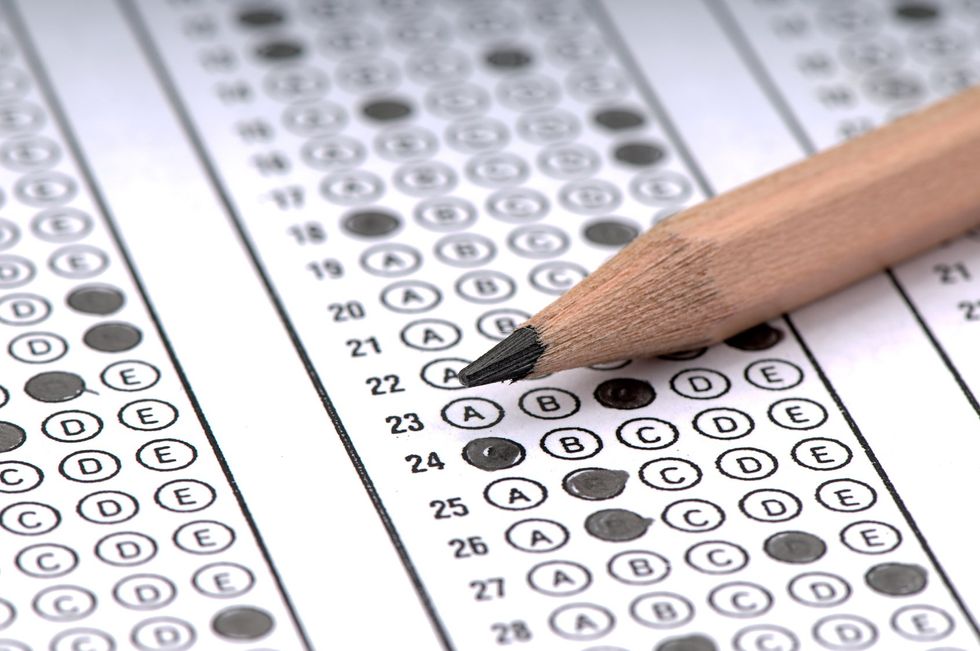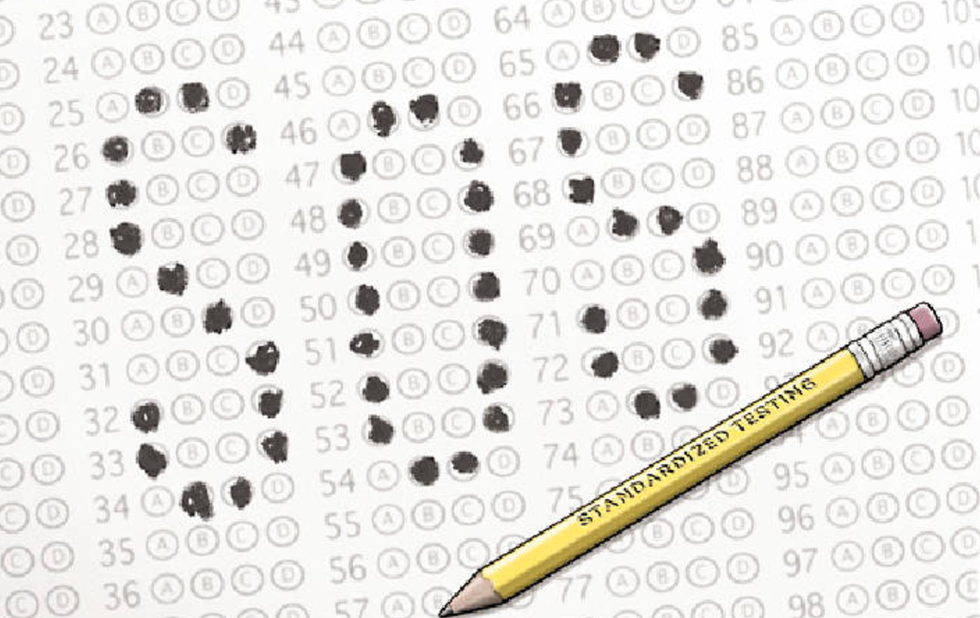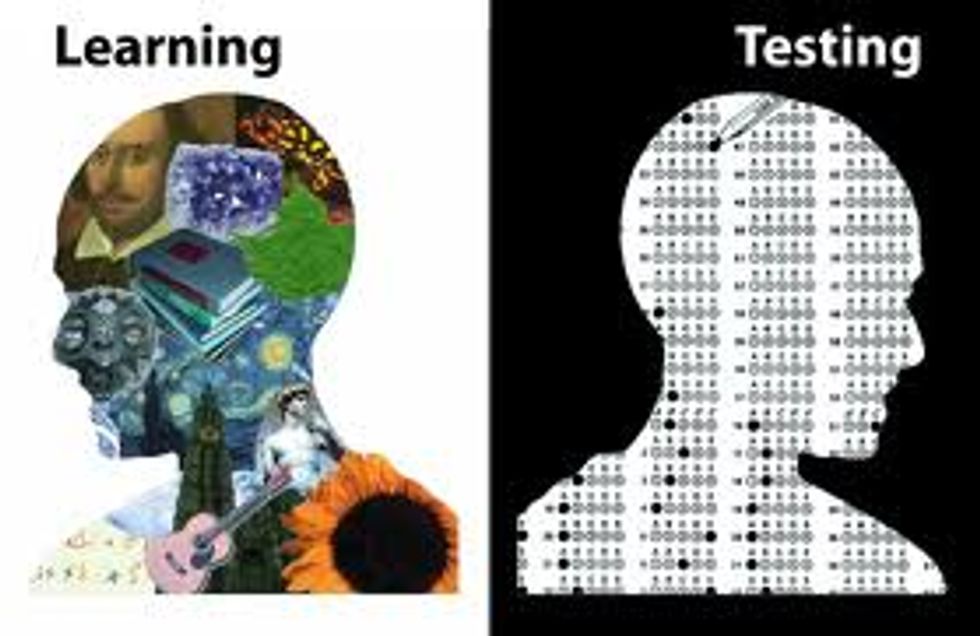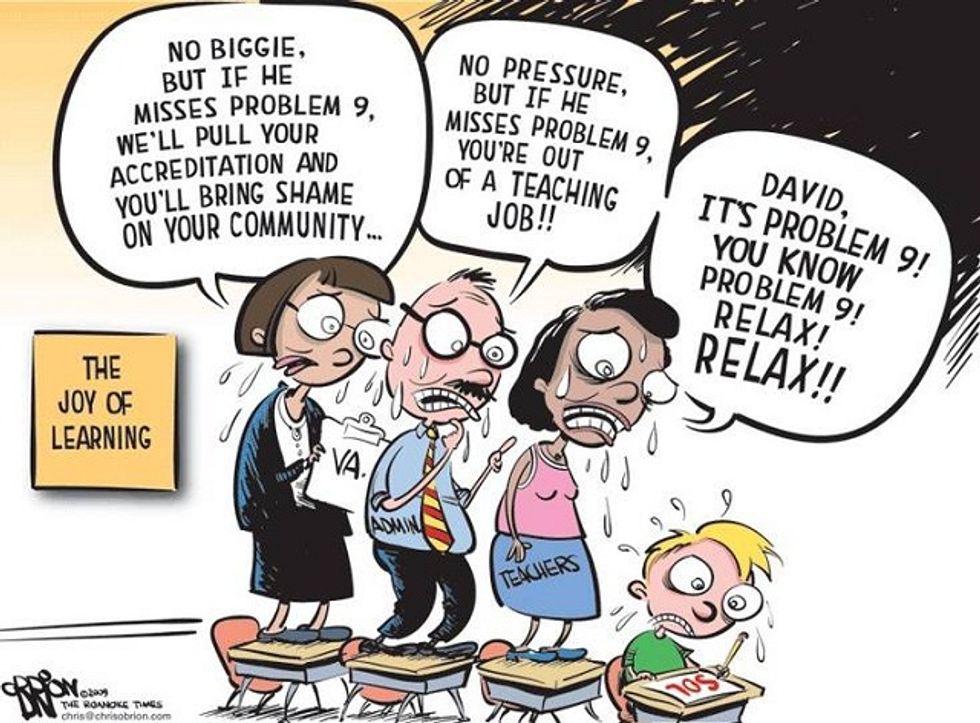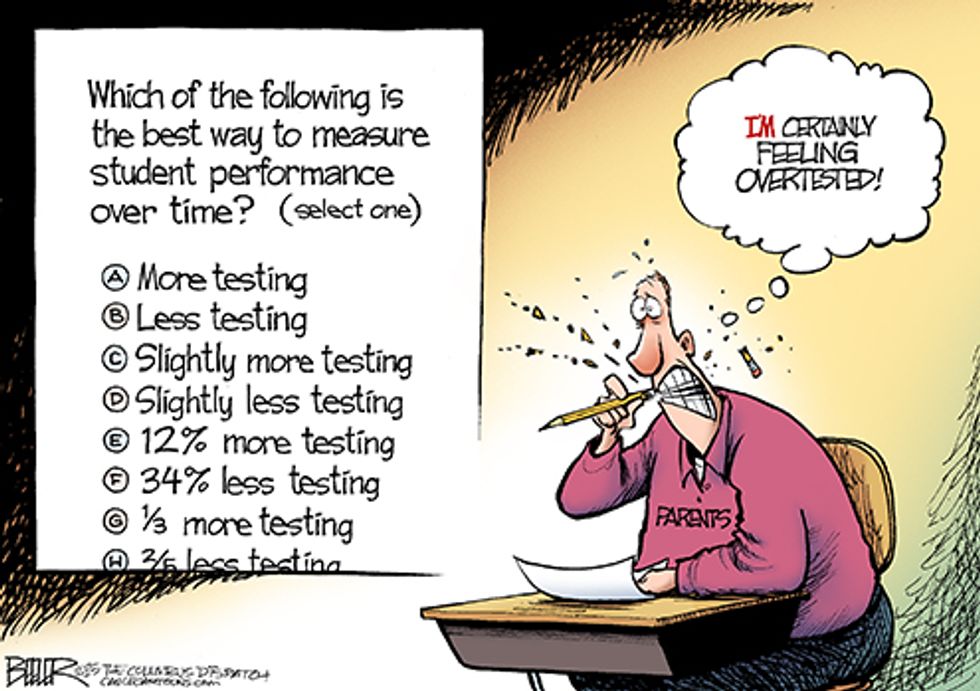When a child is learning to ride a bicycle without training wheels, he always falls from time to time. He might get a scrape and occasionally a broken bone, but always recovers and continues to learn to ride the bike. Yet when a child messes up on a standardized test in school, he might not always get the opportunity to recover since his scores help determine important directions in his educational path. This is why some people oppose standardized testing and claim that it is not an adequate method in assess students’ academic strengths and weaknesses. Others say that the administration of standardized testing is effective and should be used to measure students’ strengths on a large scale, as each school has a unique learning environment. Considering both sides of the issue, the endorsement of standardized testing should not be used on students because it is ineffective in measuring academic progress and skills, it puts too much pressure on students, and it discriminates against certain groups of people.
On average, a student takes a standardized test 112 times during his or her time in grade school, from the beginning of kindergarten to the end of 12th grade. Standardized tests are exams given in a consistent manner, meaning that their scoring procedures, testing procedures, and questions stay consistent to ensure that testing is similar for all students taking them in order to compare a student’s performance to the performances of others of their age/grade. There are three types of standardized tests: aptitude tests such as the SAT or the ACT, which are meant to test the potential to develop proficiency in an area, intelligence tests which are meant to evaluate a person’s mental capabilities, and achievement tests such as state exams, which are meant to assess mastery of certain skills. The administration of standardized tests has been endorsed by the 2001 No Child Left behind Act, which mandates testing in reading and math for all students in grades 3-8 to determine who is proficient academically and also evaluate schools as a whole based on the overall performances of students. Schools are thus determined to be ‘successes’ or ‘failures’ based on how many students do well on the exam, and performance on standardized tests determine subsidies for certain schools.
According to test makers such as the College Board, schools need a basis, or some sort of benchmark that points out students’ strengths and weaknesses as well as their educational growth for a variety of reasons. One obvious reason lies behind the fact that public education is subsidized via tax dollars. If citizens are paying taxes that are used for education, then they obviously deserve to know how their students are performing academically. Test makers state that it would be corrupt and suspicious for schools to keep information about their students’ effectiveness secretive.
Furthermore, testing companies claim that less emphasis on standardized tests would create negative, unintended consequences as well. Standardized tests are crucial to comparing students for college admissions or scholarships. Analyzing a student’s GPA and grades can somewhat help evaluate his or her performance, but these values are subjective since every school and teacher grades differently. Standardized testing is currently the only objective measure of a student. A University of California 2012 survey of admissions officers concluded that the removal of standardized tests such as the SAT or ACT would force them to resort to the subjective Grade Point Averages for admission; therefore they would have to raise the requirements to unrealistic expectations. GPA is subjective, therefore schools can easily inflate their students’ Grade Point Averages. Studies show that it is usually schools in wealthier areas that do this. According to Stanford Professor Stuart Rojstaczer, the average GPA in the wealthiest private schools has risen from 2.52 to 3.11 in the past 50 years, while the average GPA in public schools has only experienced a .2-point increase. A difference in increase can reflect upon better prep materials, but the only way that wealthy schools increased their average GPA 3x the rate of average schools is that they inflated it. So using GPA can in fact put poorer students at a disadvantage.
Even some educators are proponents of standardized testing because they feel that the use of testing will focus the curriculum on essential skills that students need to master. They note the falling emphasis on educating students in making this claim. Educators and school boards cite that over 2.5 million high-profile jobs are unfilled in the United States because many Americans do not have the reading or STEM skills necessary to fulfill qualification requirements. This is in part due to the faltering education system in the United States. Currently, the US ranks 17th in math out of 19 countries evaluated and 21st in problem solving out of 23 countries evaluated. Proponents of testing use this statistic to emphasize the need to focus school curriculums on content that will qualify Americans for high-profile jobs. Since the purpose of employing standardized tests is to assess strengths and weaknesses, then schools can easily pinpoint what their students are struggling in to ensure that they have a solid understanding of content necessary to succeed in high-profile jobs. When surveyed, over 90 percent of the 56 teachers in Kentucky claimed that basing curriculum off of scores from pre-tests led most of their students to score substantially higher in the content areas they were weak in. It is unlikely that the students in Kentucky discussed in the survey would have improved their content areas had there not been so much emphasis on their weak content areas. Yet first, schools had to identify weak links, and that required testing. With a more solid understanding of content, Americans will hopefully be more proficient and qualified for better jobs.
Educators are also proponents of standardized testing because they are able to determine students’ academic placement. A survey of 61 teachers in Minnesota regarding how effective standardized tests are in evaluating both students and teachers concluded that more than 85% of the teachers were satisfied by the feedback they received from exit exam scores because they could easily determine what students needed help or excelled in a subject based on their percentiles. When teachers are easily able to determine a student’s grasp on a subject, they can easily make academic recommendations and place students at the appropriate academic level. Students that are struggling in a subject can be placed in a support group that helps them understand the basics, while students that excel can be placed in advanced courses where they can be challenged. This can further help proficiency of important because ensures that students that need help in being proficient receive that help and ensures that students who are proficient in a subject are challenged and thus more engaged in education.
However, although unintended, negative consequences can result from the lack of standardized testing, the presence of standardized testing also creates negative consequences. In fact, these negative effects are even stronger than the lack of testing, so using standardized tests in fact hurt education as the harms outweigh the benefits. Those who claim that it’s effective and necessary in educating students are simply just ignoring the many large flaws in standardized tests.
First of all, standardized tests are not effective in measuring students’ academic progress and skills. They are not the effective ‘benchmark’ that gives educators insightful feedback on students’ performance in specific content areas. When twelve teachers at Maple Elementary School were interviewed in 2013 regarding the school’s recent ‘Title I Academic Achievement Award’ given to title I schools that have made significant gains on standardized tests, all twelve of them stated that their students’ performances did not improve enough to get an award the previous year by simply basing their learning off of their standardized test scores, but improved when the school began to create a more positive and engaging learning environment by encouraging strong teacher-student bonds and did not base learning off of previous test scores. As demonstrated by the worked example in Maple Elementary School, the strength and weakness indicators of standardized testing trivially help a school improve. Just plainly letting students and educators know how they are performing does not guarantee improvement without any push for it such as a positive learning environment. Maple Elementary School also demonstrated that positively reinforcing children by improving the learning environment can stand alone without using standardized test scores.
Standardized tests incorrectly evaluate student growth and the effectiveness of teachers as well. A teacher in Long Island was deemed a ‘failure’ as her effectiveness dropped from the 70th percentile to the 6th percentile in part because one student who received a perfect score in a prior state test missed two answers on the latter. Many other students in the teacher’s class that scored exceptionally high on the previous exam also scored slightly lower on the latter. When one scores exceptionally high or receives a perfect score, it’s not unlikely that they will score slightly lower due to reasons such as petty mistakes. What test companies fail to acknowledge in measuring student growth and teacher effectiveness through standardized testing is that there are students who already have grasped the material. Tests just blindly determine student improvement regardless of how high they scored previously; they just determine who scored higher than before. The administration of testing to determine student improvement and teacher success in educating students is thus too rigid and should not be enacted.
Large corporations such as Harcourt Educational Management and Houghton Mifflin write and administer many standardized exams; therefore they cannot make a test that directly tends to the material that students have learned in school, as they are oblivious to the immense diversity in curriculum at the regional and local level. For example, Timothy Shanahan, a former professor at the University of Chicago stated that reading comprehension exams do not really just test a student’s ability to read but other skills vocabulary and reading speed, skills that are taught differently in each region. The answer to a question might be straightforward, but a long passage or difficult vocabulary word might throw a student from guessing right . There is no way to tell if a low scorer actually struggles in reading comprehension or if he is just a slow reader or struggles with vocabulary.
Moreover, standardized tests can be so high- stakes and intense that they can put too much pressure on students and harm their learning environment. Seymour Sarason, a professor at Yale University once said, We live in a test-conscious, test-giving culture in which the lives of people are in part determined by their test performance." His statement was never the smallest bit incorrect. Currently, standardized testing, especially achievement and aptitude testing such as the PSAT, is being used to measure the quality of education and potential to enjoy important academic rewards such as scholastic and merit scholarships such as the National Merit Scholarship or admission into certain programs such as accredited dual-degree programs at the University of Pennsylvania. Whether a student deserves a reward such as a scholarship or not should obviously not be based off a number produced by a few hour test, but the student’s personal qualities such as charisma, perseverance, and compassion that can be reflected by an essay. The fact that scores on standardized tests are taking the place of other important measures such as a student’s personality as a whole and essay puts pressure on students to do well on exams, which creates traumatic effects on the education system.
The immediate effect of high-intensity exams is that the stress of preparing for such important exams can have detrimental effects on students’ welfare. Childhood is supposed to be the most crucial period in one’s lifetime for development. If one’s health is severely affected during adulthood, it is not as big of a deal as if one’s health is affected during childhood because health defects impact growth as well. Unfortunately, that is not the case due to standardized testing. There is a variety of both physical and mental illnesses associated with anxiety over standardized testing including mental breakdowns, panic attacks, vomiting, and especially sleeplessness which affects students’ growth. In a 30-question survey given to students in elementary and middle schools in a Midwestern state in 2013 regarding physical and psychological reactions triggered by test anxiety, over 44% of students reported moderate cases and over 10% reported severe cases of reactions such as odd behaviors and sleep deprivation. If we want our children to be educated well, then it is important to make sure they develop adequately. Why try to educate them by subjecting them to so much stress and negatively affecting their health when it is better to let them learn stress-free and in good health?
The intensity of tests can be so high that aside from the mental and physical harms created, it can encourage cheating. According to Campbell’s Law created by sociologist Donald Campbell, any time huge stakes are applied to quantitative data, it will become distorted through flaws and inconsistencies such as anxiety and cheating. Campbell’s Law applies to standardized testing just perfectly. If students are pressured so much to do well and they suffer so much anxiety from the pressure, then they would obviously be compelled and willing to cheat in order to get the results they desire, and of course need. The immense amount of statistics related to cheating on standardized tests help prove the connection between Campbell’s Law and standardized testing. In a look in students’ scores on tests in six states and the District of Columbia, representatives from USA TODAY found over 1,610 anomalies such as abnormally high erasure rates and removal of names from test rosters in a span of only five years, which hints an explanation of the rising number of cheating scandals in major cities such as St. Louis, Washington DC, and Atlanta. In a way, cheating is an effect of the psychological torture to students. Students who cheat are usually showing how potentially sick and stressed they are of preparation for important tests. They have potentially worked so hard up to the point of an important test, and they cannot mess up. Students clearly do not want a stressful environment full of important testing in school, and educators should grant their wish.
The intensity of these exams also harms the learning habitat in schools. Preparation for standardized tests often causes teachers to ‘teach to the test,’ creating a rigid learning structure, thus preventing students from expressing themselves. A goal of education is to encourage students to become creative and express their thoughts to the greatest level possible; however testing students prevents that. Former English teacher Marion Brady from Stockport, Ohio reflected on her students' creativeness and willingness to learn new things was most apparent when schoolwork was self-propelled driven by curiosity. As mentioned before, children grow the best when subjected to a creative and engaging learning environment. Due to standardized testing, teachers often just rigidly teach to prepare students by employing rock- solid learning structures such as strict algorithms and intense drills that students use to prepare for these standardized exams as opposed to showing their own potential fulfillment and enthusiasm for educating them. In a survey of 52 school districts across 6 West Coast US States regarding how teachers spend instructional time, over 71% of the school districts claimed that they were forced to cut time drastically out of enrichment activities such as fine arts and field trips to prepare for standardized English and Math tests. When time for students to enjoy a firsthand experience in education is taken away, the students will lose the enthusiasm for education they deserve to have. Students are not meant to be ‘machines’ cranking out scores on exams, they are meant to be humans meant to enjoy and be enthusiastic about their childhood.
Standardized tests can also be discriminatory against the poor, the disabled, and even minority groups. Since standardized tests are made by large corporations such as Houghton- Mifflin, many of the questions in turn are designed to benefit some people at the cost of others. They often benefit the wealthy. The Northwest Evaluation Association’s Measures of Academic Progress testing program, a series of nationally recognized exams in reading and mathematics, is currently under fire after over 55% of questions on all their reading tests and over 35% of questions on their mathematics tests were found to be associated with the etiquette of the upper class. What this means is that standardized tests contain words or phrases that only the rich would know or use in daily language. This gives a huge advantage to the rich as they will be able to break down the questions much easier than the lower classes.
As well as being able to answer questions more easily, students of wealthier backgrounds are also more prepared for standardized exams. Students of the upper class are obviously able to afford more test prep programs. It is estimated that of the 300+ point difference in scores on the SAT between high-income and low-income families, access to tutoring from test prep companies contributes to over 150 points of a difference. Since the wealthy are given access to a greater amount of preparation for standardized tests, it’s not surprising that wealthier students will do well on exams. Only the rich can learn certain strategies or tricks on how to conquer the test that will be unavailable to the poor. As well as being less prepared for standardized tests, poorer students are put at a further disadvantage as test- taking forms modernize. Many living in poverty are not able to afford technologies such as computers. The poorest 20% of Philadelphia schools currently own only 27% of the resources such as books and computers that the Philadelphia School Board requires them to have. So the fact that poorer students are denied resources and technology to prepare for tests will compound the score gap with the lack of tutoring.
Also, as testing procedures are rapidly changing, and some tests are now even computerized, students in poverty will consequently struggle to keep up with new testing procedures in terms of understanding them. Essentially, using standardized testing does not accurately assess how academically proficient a student is. Wealthy students are theoretically just going to do much better than poorer students.
Consequently, the scores of African Americans and Latinos are being reflected upon this cycle of wealth and education. The average SAT Reading test score of Blacks and Latinos is 429/800 while the average SAT Reading test score is 528 for whites. A 99-point difference is nothing to ignore, as it is enough of a difference for colleges to differentiate between students. We have spent over 100 years fighting for equal rights for African Americans, yet they are still denied the rights of fair educational opportunities due to standardized testing.
If we are going to stop using standardized testing, we cannot ignore the subjectivity of most other measures used to evaluate a student and/or assess strengths and weaknesses such as Grade Point Averages and Class Rank. Yet due to its flaws such as its discriminatory nature and its ineffectiveness, we cannot keep standardized testing so high stakes. Although it is ideal to abandon standardized testing all together, it would not be a bad idea to minimize its intensity.

